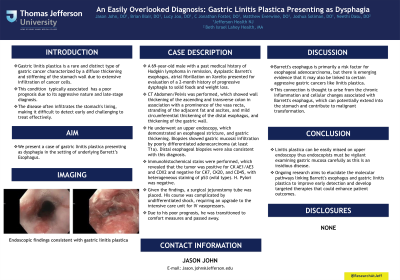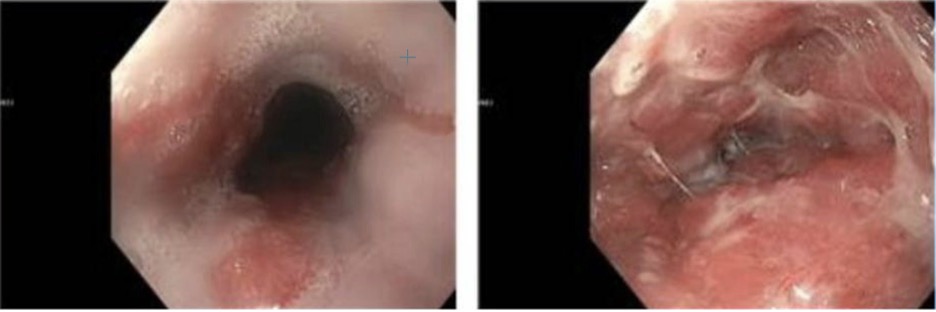Tuesday Poster Session
Category: Stomach
P5123 - An Easily Overlooked Diagnosis: Gastric Linitis Plastica Presenting as Dysphagia
Tuesday, October 29, 2024
10:30 AM - 4:00 PM ET
Location: Exhibit Hall E

Has Audio
- JJ
Jason John, DO
Jefferson Health
Pennsauken, NJ
Presenting Author(s)
Jason John, DO1, Brian Blair, DO2, Lucy Joo, DO2, C. Jonathan Foster, DO2, Matthew Everwine, DO3, Joshua Soliman, DO3, Neethi Dasu, DO4
1Jefferson Health, Pennsauken, NJ; 2Jefferson Health, Cherry Hill, NJ; 3Jefferson Health, Washington Township, NJ; 4Beth Israel Lahey Health, Burlington, MA
Introduction: Gastric linitis plastica is a rare and distinct type of gastric cancer characterized by a diffuse thickening and stiffening of the stomach wall due to extensive infiltration of cancer cells. We present a case of gastric linitis plastica presenting as dysphagia in the setting of underlying Barrett’s Esophagus.
Case Description/Methods: A 69-year-old male with a past medical history of Hodgkin lymphoma in remission, dysplastic Barrett's esophagus, atrial fibrillation on Xarelto presented for evaluation of a 2-month history of progressive dysphagia to solid foods and weight loss. CT Abdomen/Pelvis was performed, which showed wall thickening of the ascending and transverse colon in association with a prominence of the vasa recta, stranding of the adjacent fat and ascites, and mild circumferential thickening of the distal esophagus, and thickening of the gastric wall. He underwent an upper endoscopy, which demonstrated an esophageal stricture, and gastric thickening. Biopsies showed gastric mucosal infiltration by poorly differentiated adenocarcinoma (at least T1a). Distal esophageal biopsies were also consistent with this diagnosis. Immunohistochemical stains were performed, which revealed that the tumor was positive for CK AE1/AE3 and CDX2 and negative for CK7, CK20, and CD45, with heterogeneous staining of p53 (wild type). H. Pylori was negative. Given the findings, a surgical jejunostomy tube was placed. His course was complicated by undifferentiated shock, requiring an upgrade to the intensive care unit for IV vasopressors. Given his poor prognosis, he was transitioned to comfort measures and passed away.
Discussion: Barrett's esophagus is primarily a risk factor for esophageal adenocarcinoma, but there is emerging evidence that it may also be linked to certain aggressive gastric cancers like linitis plastica. This connection is thought to arise from the chronic inflammation and cellular changes associated with Barrett's esophagus, which can potentially extend into the stomach and contribute to malignant transformation. Linitis plastica can be easily missed on upper endoscopy thus endoscopists must be vigilant examining gastric mucosa carefully as this is an insidious disease. Ongoing research aims to elucidate the molecular pathways linking Barrett's esophagus and gastric linitis plastica to improve early detection and develop targeted therapies that could enhance patient outcomes.

Disclosures:
Jason John, DO1, Brian Blair, DO2, Lucy Joo, DO2, C. Jonathan Foster, DO2, Matthew Everwine, DO3, Joshua Soliman, DO3, Neethi Dasu, DO4. P5123 - An Easily Overlooked Diagnosis: Gastric Linitis Plastica Presenting as Dysphagia, ACG 2024 Annual Scientific Meeting Abstracts. Philadelphia, PA: American College of Gastroenterology.
1Jefferson Health, Pennsauken, NJ; 2Jefferson Health, Cherry Hill, NJ; 3Jefferson Health, Washington Township, NJ; 4Beth Israel Lahey Health, Burlington, MA
Introduction: Gastric linitis plastica is a rare and distinct type of gastric cancer characterized by a diffuse thickening and stiffening of the stomach wall due to extensive infiltration of cancer cells. We present a case of gastric linitis plastica presenting as dysphagia in the setting of underlying Barrett’s Esophagus.
Case Description/Methods: A 69-year-old male with a past medical history of Hodgkin lymphoma in remission, dysplastic Barrett's esophagus, atrial fibrillation on Xarelto presented for evaluation of a 2-month history of progressive dysphagia to solid foods and weight loss. CT Abdomen/Pelvis was performed, which showed wall thickening of the ascending and transverse colon in association with a prominence of the vasa recta, stranding of the adjacent fat and ascites, and mild circumferential thickening of the distal esophagus, and thickening of the gastric wall. He underwent an upper endoscopy, which demonstrated an esophageal stricture, and gastric thickening. Biopsies showed gastric mucosal infiltration by poorly differentiated adenocarcinoma (at least T1a). Distal esophageal biopsies were also consistent with this diagnosis. Immunohistochemical stains were performed, which revealed that the tumor was positive for CK AE1/AE3 and CDX2 and negative for CK7, CK20, and CD45, with heterogeneous staining of p53 (wild type). H. Pylori was negative. Given the findings, a surgical jejunostomy tube was placed. His course was complicated by undifferentiated shock, requiring an upgrade to the intensive care unit for IV vasopressors. Given his poor prognosis, he was transitioned to comfort measures and passed away.
Discussion: Barrett's esophagus is primarily a risk factor for esophageal adenocarcinoma, but there is emerging evidence that it may also be linked to certain aggressive gastric cancers like linitis plastica. This connection is thought to arise from the chronic inflammation and cellular changes associated with Barrett's esophagus, which can potentially extend into the stomach and contribute to malignant transformation. Linitis plastica can be easily missed on upper endoscopy thus endoscopists must be vigilant examining gastric mucosa carefully as this is an insidious disease. Ongoing research aims to elucidate the molecular pathways linking Barrett's esophagus and gastric linitis plastica to improve early detection and develop targeted therapies that could enhance patient outcomes.

Figure: Endoscopic findings consistent with gastric linitis plastica
Disclosures:
Jason John indicated no relevant financial relationships.
Brian Blair indicated no relevant financial relationships.
Lucy Joo indicated no relevant financial relationships.
C. Jonathan Foster: Conmed – Consultant. Steris – Consultant.
Matthew Everwine indicated no relevant financial relationships.
Joshua Soliman indicated no relevant financial relationships.
Neethi Dasu indicated no relevant financial relationships.
Jason John, DO1, Brian Blair, DO2, Lucy Joo, DO2, C. Jonathan Foster, DO2, Matthew Everwine, DO3, Joshua Soliman, DO3, Neethi Dasu, DO4. P5123 - An Easily Overlooked Diagnosis: Gastric Linitis Plastica Presenting as Dysphagia, ACG 2024 Annual Scientific Meeting Abstracts. Philadelphia, PA: American College of Gastroenterology.
